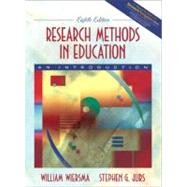“This is a wonderful text book for an educational research course, and a highly desirable resource to help students or educators gain profound insight about methods, designs, procedures, and writing of educational research.”
Leping Liu, University of Nevada, Reno
“This text is the most "user-friendly" research text that I have found. The progression of ideas is wonderful, building on prior concepts without overwhelming or confusing the reader.”
Roxanne DelaVecchia, Towson University
A classic in its field, Research Methods in Education, Eighth Edition explores quantitative and qualitative research from beginning to end, starting with the formulation of a research question straight through to publication. Retaining the clear, concise writing style and organization that has made this text so popular, Research Methods in Education helps students evaluate research literature as well as master research methodology.
New To This Edition
- Enhanced experimental validity sections. Provides students with proper criteria for judging the quality of research (Chs. 16 & 17).
- New! Writing a research proposal. Thoroughly outlines each stage of the process to prepare students in developing their own proposal (Ch. 16).
- Improved coverage of the process of identifying and writing research questions—the driving force behind the entire research process.
- Expanded coverage of technology and the use of electronic resources. Offers students an in-depth exploration in research from web referencing to data analysis and much more!
- Brand new coverage of Mixed Methods and Delphi Studies. Adds a new dimension to the text to keep current with practice.
Research Navigator access is provided with the text and integration is provided through the use of key-term icons and chapter ending activities. This database provides discipline-specific academic resources as well as helpful tips on the writing process, online research, and finding and citing valid sources. See the inside front cover for details!









